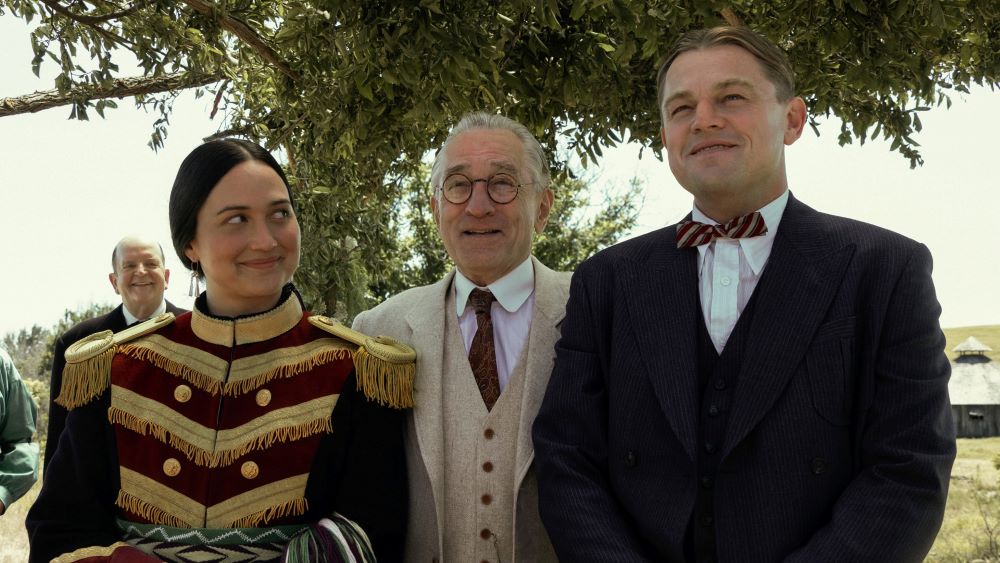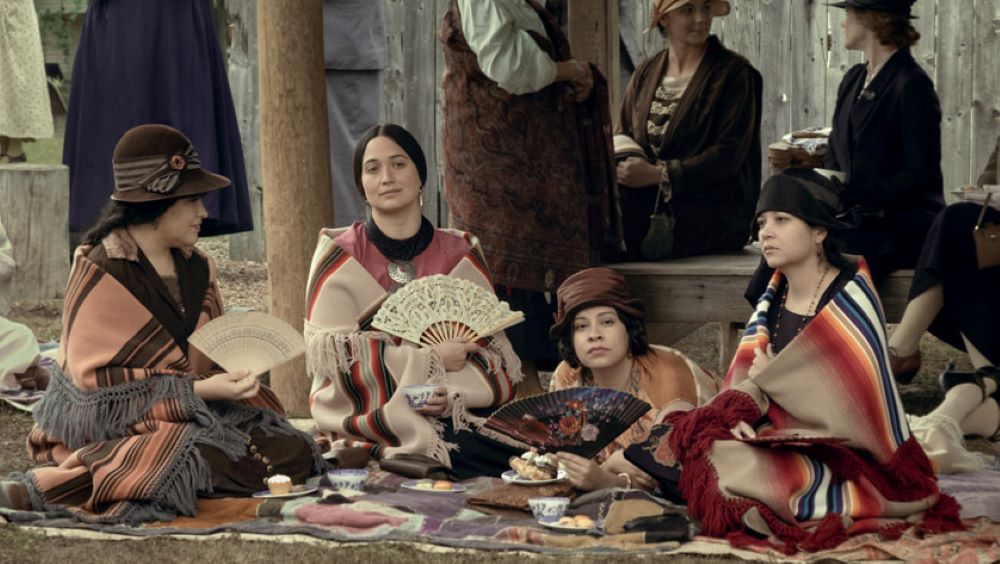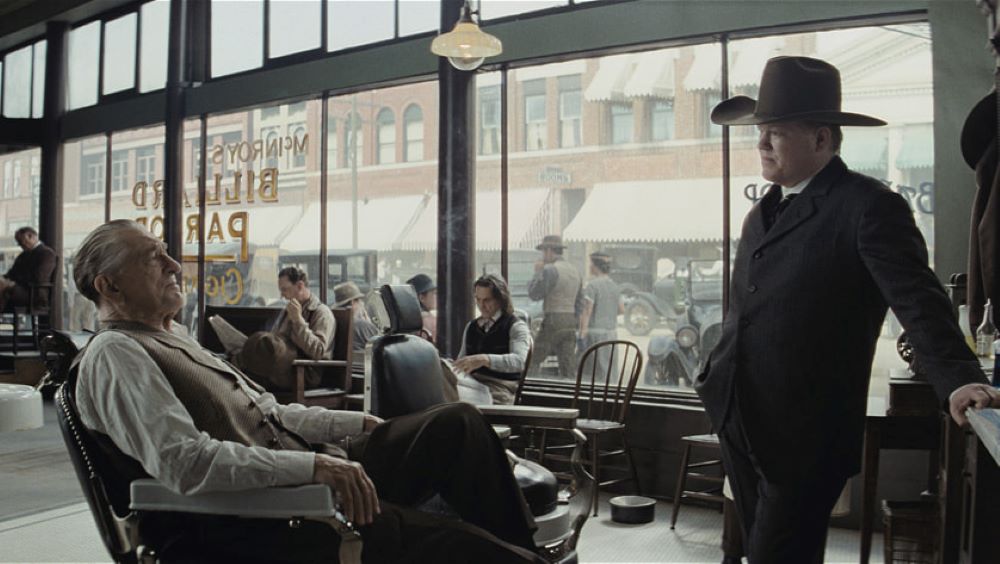
Lily Gladstone, Robert De Niro and Leonardo DiCaprio star in "Killers of the Flower Moon." The Martin Scorsese film depicts the murders of Osage Nation members in Oklahoma. (AppleTV+)
Martin Scorsese has written his thesis on America.
With a three-and-a-half hour runtime, "Killers of the Flower Moon" is both mammoth and monolith. In spite of its gargantuan length, this is a film that wastes no time in letting you know what it is about and how things are going to go. Over the course of the movie, Scorsese damns American imperialism and all of its various facets, from the friendly faced swindler who will learn your language just to steal from you to the imbecilic everyman who is too fool to truly comprehend his role in a patriarchal white supremacist system. Raised in a working-class Catholic environment in New York, Scorsese's natural inclination has always been toward pointing out injustices in society — and this film is no different.
"Killers of the Flower Moon," which originated as a nonfiction book by David Grann, concerns the Osage Nation, a Native American tribe forced to move from Kansas to modern-day Oklahoma. Unbeknown to the U.S. government, the land allotted to the Osage turned out to be rich in oil, which resulted in many of the Osage becoming wealthy. A number of scenes early in the film, as well as its opening montage, portray the reversal of fortunes: White men are forced to grovel at the feet of the Osage for a pittance of their riches. But white greed knows no bounds and a criminal conspiracy quickly forms to rob the Osage of their property, through no shortage of spilled blood.
Why steal from the Osage? Not because of any notions that the Osage’s land should belong to whites. No, it is simply greed.
Here, the film shows its double nature: for a contemplative piece — with much to say about colonialism and racism — it is, at the end of the day, a classic Scorsese crime drama.
In many ways, it is a synthesis of his two most recent films: the meditative spirituality of "Silence" is present, as is the grand yet existentially exhausting plain-facedness of "The Irishman." "Killers" addresses the Osage’s beliefs in a way that feels true and authentic, backed up by the Osage themselves with whom Scorsese worked extensively to ensure that the tribe’s portrayal was accurate and fact-based. It echoes his loving portrait of Japanese Catholicism in "Silence," a film that similarly grapples with cultural colonialism and a fundamental incompatibility between two very different groups of people.

The cast of Martin Scorsese's "Killers of the Flower Moon" includes, from left, JaNae Collins, Lily Gladstone, Cara Jade Myers and Jillian Dion. (AppleTV+)
The comparison to "The Irishman" comes unsurprisingly in both films' portrayals of their titular criminals. To them, crime is a mere eventuality — things that one just does as a matter of course. One needn't think of it beyond that. Why steal from the Osage? Not because of any notions that the Osage’s land should belong to whites. No, it is simply greed. Scorsese portrays the mundanity of it so well. As much as there might be a Machiavellian plot behind the murders perpetrated against the Osage, so much of the evil is humdrum and largely carried out by a collection of hapless incompetents.
There is a lot of "Goodfellas" in this movie's DNA, even if it only comes out every so often, reminding the viewer that they are, in fact, watching a Scorsese movie. This is both to the film's benefit and to its detriment: Sometimes the tropey Scorsese crime antics that emerge, complete with his signature black humor, feel out of place within the otherwise ponderous drama that is "Killers." One murder feels accidental, in spite of extensive planning, and its perpetrator screws up its execution so badly that it turns nearly to farcical comedy. It is in these moments that it feels like vintage Scorsese is being uncorked; there is, after all, nothing he does better than foolish criminals.
Leonardo DiCaprio plays against type as the prime fool, Ernest Burkhart, a veteran fresh from World War I. It is entertaining to see the ordinarily charismatic DiCaprio play a character so uneducated and out of his depth that he seems to perpetually stumble into his criminality. Never has crime looked so passive and incidental.

Playing his mentor and uncle (not to mention the one who gets him roped into the business of murder) is Robert DeNiro as William King Hale, whom everyone calls King. DeNiro's King is devil-esque in his ability to befriend and make family those he longs to kill and steal from, and DeNiro easily sells the classic colonial entitlement his character represents.
The real showstopper, however, is Lily Gladstone, in a star-making role. She plays Mollie Burkhart, Ernest's Osage wife. Her role in the story begins with quite a bit of agency before descending slowly into maddening numbness as personal tragedies pile on. Gladstone's ability to place so much power in her acting in spite of her loss of control is something to behold. Though she speaks less and less as the film goes on, Gladstone's screen presence is utterly commanding and must be seen to be believed. She manages to outshine both DiCaprio and DeNiro.
Technically, the film is a marvel. Rodrigo Prieto's shot composition is so beautiful that it is almost a shame that the vast majority of the people who will watch the film will do so on television screens (the film has a brief theatrical window before dropping on Apple TV+). Scorsese's longtime editor, paces "Killers" so well that it moves at a brisk clip despite its length. Special praise must go to composer Robbie Robertson, who died a few months before the film's release. His score is pulse pounding, a throbbing heartbeat of a bass line that keeps the tension high even during the slowest parts of the movie. It makes the film feel like a wild animal; you never know when or if it is going to pounce.
Advertisement
The film's source text, Killers of the Flower Moon: The Osage Murders and the Birth of the FBI, placed more emphasis on the role that J. Edgar Hoover and the freshly-formed Federal Bureau of Investigation played in solving the Osage murders. Scorsese, however, wisely sidesteps any white savior narrative that might emerge from this and focuses entirely on the killers and the victims, making no illusions about who is at fault and who suffered. Scorsese turned what could have been a whodunit murder mystery into a profound portrait of the evils of the American empire, the insidiousness of Manifest Destiny and the lengths that those who perpetuate white supremacy will go to in order to maintain their sense of self-righteous entitlement.
Scorsese may be best known as one of the world's premiere Catholic filmmakers, but he is also first and foremost an American filmmaker — and "Killers of the Flower Moon" may be his final word on America, a blood-soaked condemnation of a country whose gospel of greed has caused much death and destruction. And yet his Catholicism is prevalent, too, in his caring depiction of the Osage, a marginalized group if ever there was one. For all the suffering they had to go through, the Osage endured. They are still here. They survived these murders, survived American evil long enough to be able to tell their story. And what a story it is.








